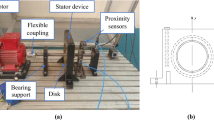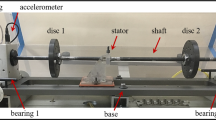The vibrations of a double-seat weighty rotor of the steam turbine with a breathing transverse crack are examined in the field of operating environment temperatures. The 3D vibration model for the rotor with a breathing transverse crack is applied. The variable two-dimensional temperature field is found from the solution of nonstationary heat transfer problem. Its effect on the contact of crack edges on rotor vibrations was evaluated. The distribution of stress intensity factors along the crack front was established for different rotor positions. Fatigue crack extension modes are assessed.





Similar content being viewed by others
References
A. S. Goldin, “Thermal unbalance of the rotor,” Sborka Mashinostr. Priborostr., No. 4 (105), 52–56 (2009).
V. V. Matveev, A. P. Yakovlev, O. E. Boginich, and E. A. Sinenko, “Approximate analytical determination of vibrodiagnostic parameters of the presence of a closing crack in bar elements under subharmonic resonance,” Strength Mater., 46, No. 3, 315–327 (2014).
A. S. Sekhar, A. R. Mohanty, and S. Prabhakar, “Vibrations of cracked rotor system: transverse crack versus slant crack,” J. Sound Vib., 279, 1203–1217 (2005).
A. R. Dimarogonas, “Vibration of cracked structures: a state of art review,” Eng. Fract. Mech., 55, 831–857 (1996).
A. K. Darpe, K. Gupta, and A. Chawta, “Coupled bending, longitudinal and torsional vibrations of a cracked rotor,” J. Sound Vib., 269, 33–60 (2004).
E. A. Sinenko and A. P. Zinkovskii, “Influence of the exciting force application point on the amplitude spectrum of flexural vibrations in a beam with a “breathing” crack,” Strength Mater., 47, No. 4, 553–560 (2015).
V. V. Matveev and E. A. Onishchenko, “Vibrodiagnostic parameters of the presence of a semielliptic breathing crack in circular bars under super- and subharmonic resonances,” Strength Mater., 48, No. 2, 195–207 (2016).
P. Pennacchi, N. Bachschmid, and A. Vania, “A model-based identification method of transverse cracks in rotating shafts suitable for industrial machines,” Mech. Syst. Signal Pr., 20, 2112–2147 (2000).
M. I. Friswell, “Damage identification using inverse methods,” Philos. T. R. Soc. A, 365, 393–410 (2007).
G. Sabnavis, R. G. Kirk, M. Kasarda, and D. D. Quinn, “Cracked shaft detection and diagnostics: a literature review,” Shock Vib. Digest, 36, 287–296 (2004).
R. Gasch, “Dynamic behaviour of the Laval rotor with a transverse crack,” Mech. Syst. Signal Pr., 22, 790–804 (2008).
N. Bachschmid, P. Pennacchi, E. Tanzi, and S. Audebert, “Transverse crack modeling and validation in rotor systems, including effects,” Int. J. Rot. Mach., 9, No. 2, 113–126 (2003).
N. Bachschmid and E. Tanzi, “Vibration pattern related to transverse crack in rotors,” Shock Vib., 9, Nos. 4–5, 217–224 (2002).
P. Popaleny and N. Peton, “Steam turbine rotor crack,” in: Proc. of the Int. Conf. SURVEILLANCE 7 (Oct. 29–30, 2013, Chartres, France), Institute of Technology of Chartres (2013).
P. Pennacchi and A. Vania, “Shaft crack detection in a steam turbine: experimental evidences and model-based simulations,” in: Proc. of ISMA 2010 including USD 2010 (Sept. 20–22, 2010, Leuven, Belgium), pp. 1055–1070.
N. Bachschmid, P. Pennacchi, and E. Tanzi, “Analysis of the thermal effects in rotor shaft affected by transverse crack,” in: Bollettino del C.I.L.Å.A., Research Activities on High Performance Computing Clusters at CILEA (2006), pp. 11–25.
N. G. Shul’zhenko, B. F. Zaitsev, E. K. Rudenko, and A. V. Asaenok, “Evaluation of the effect of temperature stresses on the vibrations of a rotor with a transverse crack considering edge contacts,” Visn. Zaporozh. Nats. Univ., No. 1, 218–226 (2015).
N. G. Shul’zhenko, B. F. Zaitsev, A. V. Asaenok, and T. V. Protasova, “Effect of the temperature field on the resonant vibrations of a rotor with a breathing transverse crack,” Vibr. Tekh. Tekhnol., No. 3 (83), 75–82 (2016).
N. G. Shul’zhenko, B. F. Zaitsev, N. E. Vikman, and A. V. Asaenok, “Vibration analysis of rotor with a “breathing” crack using three-dimensional model,” Strength Mater., 44, No. 6, 678–685 (2012).
A. V. Asaenok, B. F. Zaitsev, and N. G. Shul’zhenko, “Procedure for introducing virtual cuts to the FEM scheme in the problems of statics and natural vibrations of three-dimensional constructions,” Probl. Mashinostr., 6, No. 3, 58–63 (2003).
B. F. Zaitsev, N. G. Shul’zhenko, A. V. Asaenok, and N. E. Eretskaya, “Method of calculating the vibrations of bodies containing cracks with contacting edges,” Probl. Mashinostr., 11, No. 4, 34–42 (2008).
N. G. Shul’zhenko, P. P. Gontarovskii, and B. F. Zaitsev, Problems of Thermal Strengths, Vibration Diagnostics, and Life of Power Units (Models, Methods, and Research Results), LAP Lambert Academic Publishing GmbH& Co.KG., Saarbrücken (2011).
A. I. Lur’e, Theory of Elasticity [in Russian], Nauka, Moscow (1970).
B. F. Zaitsev, A. V. Asaenok, and N. E. Vikman, “Construction of mass matrices considering centrifugal forces on the vibrations of a three-dimensional rotating body,” Vestn. NTU “KhPI.” Dinam. Prochn. Mashin, Issue 30, 52–56 (2009).
K. Bathe and E. Wilson, Numerical Methods in Finite Element Analysis, Prentice-Hall, Englewood Cliffs, NJ (1976).
RTM 108.020.16-83. Calculation of the Temperature Fields of Rotors and Steam Turbine Casings [in Russian], NPO TsKTI, Leningrad (1985).
A. F. Émeri and V. V. Karson, “Evaluation of FEM applicability to temperature calculations,” Teploperedacha, No. 2, 6–17 (1971).
G. P. Cherepanov, Mechanics of Brittle Fracture [in Russian], Nauka, Moscow (1974).
E. M. Morozov and G. P. Nikishkov, Finite Element Method in Fracture Mechanics [in Russian], Nauka, Moscow (1980).
V. P. Kogaev, N. A. Makhutov, and A. P. Gusenkov, Strength and Lifetime Calculations for Machine and Structure Elements [in Russian], Mashinostroenie, Moscow (1985).
V. T. Troshchenko and L. A. Sosnovskii, Fatigue Resistance of Metals and Alloys [in Russian], Handbook in 2 parts, Naukova Dumka, Kiev (1987).
V. T. Troshchenko, V. V. Pokrovskii, and A. V. Prokopenko, Crack Resistance of Metals under Cyclic Loading [in Russian], Naukova Dumka, Kiev (1987).
Author information
Authors and Affiliations
Corresponding author
Additional information
Translated from Problemy Prochnosti, No. 6, pp. 21 – 30, November – December, 2017.
Rights and permissions
About this article
Cite this article
Shul’zhenko, N.G., Zaitsev, B.F., Asaenok, A.V. et al. Deformation and Vibration-Induced Stress Intensity of a High-Temperature Turbine Rotor with a Breathing Transverse Crack. Strength Mater 49, 751–759 (2017). https://doi.org/10.1007/s11223-018-9920-x
Received:
Published:
Issue Date:
DOI: https://doi.org/10.1007/s11223-018-9920-x




